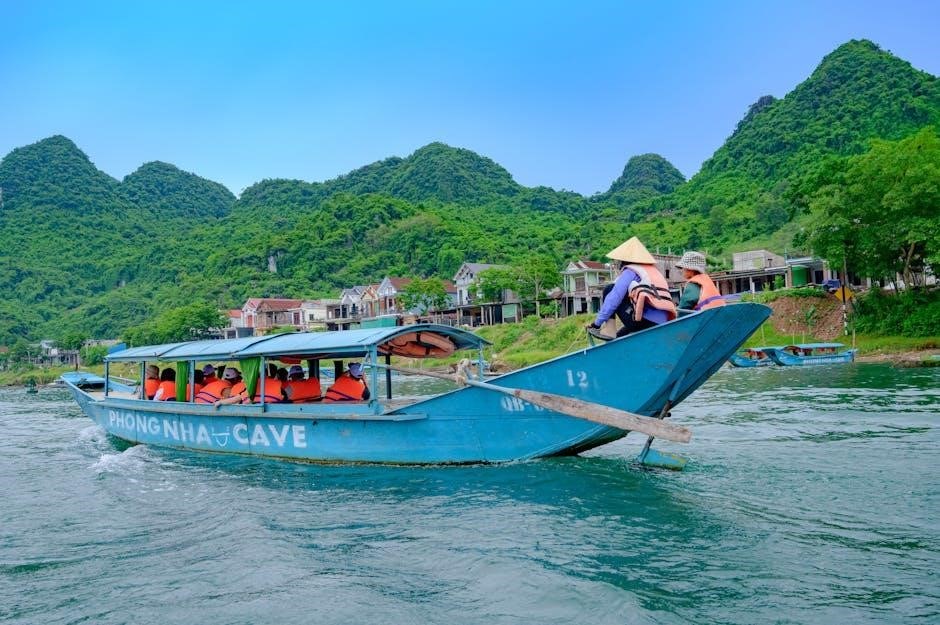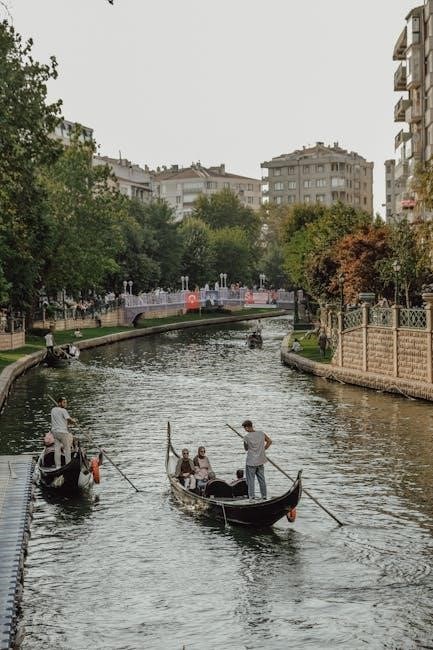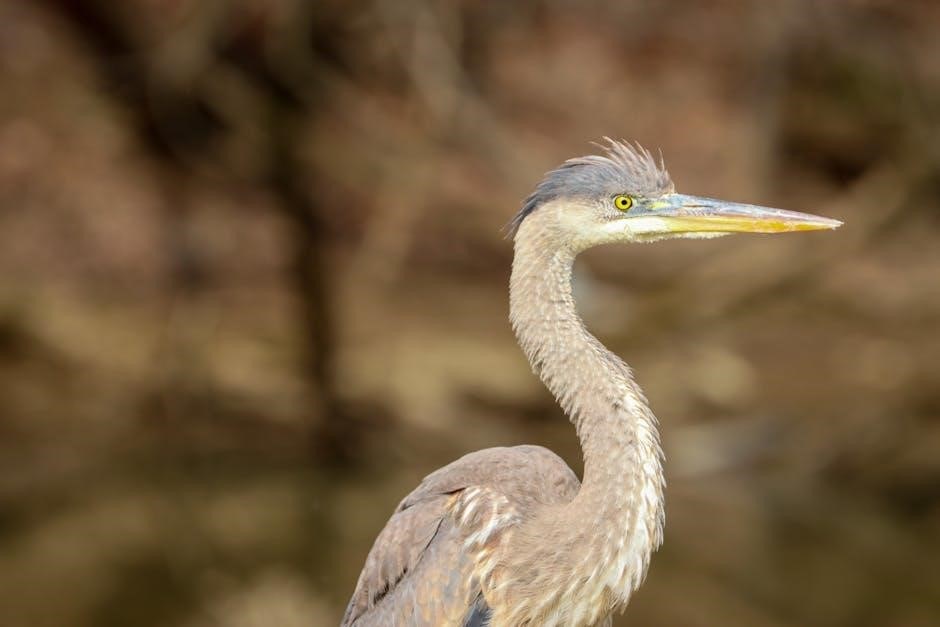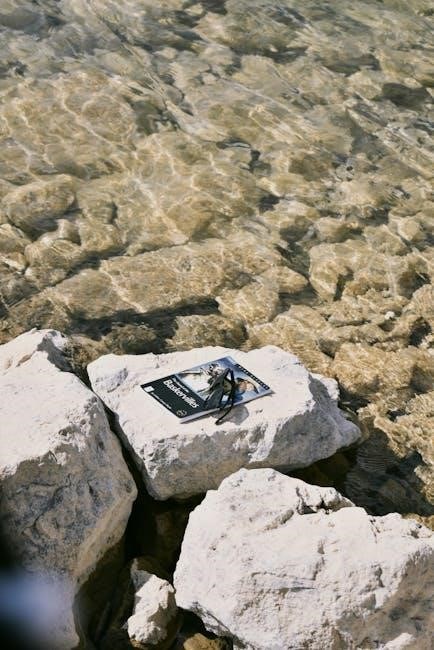River Guide: A Comprehensive Overview
River guides are essential for safe and enjoyable river adventures․ They navigate rafts, manage groups, and ensure client safety, often working for tour companies and leading daily trips․ These professionals require wilderness skills, leadership qualities, and a passion for the outdoors․ A river guide is also a storyteller, medic, chef and historian all rolled into one!

What is a River Guide? Roles and Responsibilities
A river guide is a multifaceted professional responsible for ensuring the safety and enjoyment of individuals participating in rafting or other river-based activities․ Their primary role involves navigating rafts skillfully through various river conditions, including rapids, while managing the safety of passengers․ River guides work closely with diverse groups, often including inexperienced participants, necessitating strong interpersonal and leadership skills․ They provide clear instructions, manage behavior, and maintain a safe environment throughout the trip․

Beyond navigation and safety, river guides are also responsible for preparing and maintaining equipment, such as rafts and safety gear․ They conduct pre-trip safety briefings, demonstrating proper techniques and outlining potential hazards․ Furthermore, they handle trip logistics, including reservations and communication with management․ River guides often educate clients about the local environment, history, and conservation efforts, enriching the overall experience․
In addition to their technical and managerial duties, river guides serve as storytellers, chefs, medics, and problem-solvers․ They create a positive and engaging atmosphere, sharing river lore and providing meals in remote settings․ They must be prepared to address medical emergencies and resolve unexpected issues, ensuring a smooth and memorable adventure for all participants․ Ultimately, a river guide embodies a diverse skill set, blending expertise in outdoor recreation with exceptional customer service․

Essential Skills and Qualifications for River Guides
Becoming a proficient river guide requires a combination of technical expertise, interpersonal skills, and a deep passion for the outdoors․ Essential qualifications typically include certifications in Wilderness First Responder, CPR, and Swift Water Rescue, ensuring the ability to handle medical emergencies and navigate challenging river conditions safely․ Strong swimming skills and experience rafting various river types are also crucial for effective navigation and risk management․
Beyond technical skills, river guides must possess exceptional communication and leadership abilities․ They need to effectively convey safety instructions, manage group dynamics, and maintain a positive atmosphere, even under pressure․ Adaptability and problem-solving skills are vital for addressing unexpected challenges, such as gear malfunctions or changes in river conditions․ A keen awareness of river features, currents, and potential hazards is essential for making informed decisions and ensuring passenger safety․
Furthermore, successful river guides demonstrate a strong commitment to environmental stewardship and a passion for sharing their knowledge with others․ They educate clients about local history, ecology, and conservation efforts, fostering a deeper appreciation for the natural world․ Ultimately, the ideal river guide combines technical proficiency, leadership qualities, and a genuine enthusiasm for creating memorable and educational experiences for their guests․
Types of River Training Works: Guide Banks
River training works are crucial for managing and controlling river flow, and among the various techniques employed, guide banks play a significant role․ These structures are designed to guide the river’s course, particularly where it approaches bridges, weirs, or other hydraulic structures, ensuring a straight and non-tortuous flow․ Guide banks serve to confine the river within a defined channel width, preventing erosion and protecting infrastructure․
The guide bank system, pioneered by Mr․ J․R․ Bell, involves constructing earthen embankments that direct the river’s flow․ These embankments, sometimes referred to as “Bell’s Bunds,” are strategically positioned to maintain a stable river channel and prevent the river from deviating from its intended course․ By controlling the river’s alignment, guide banks minimize the risk of scouring, sedimentation, and other undesirable effects that can compromise the integrity of hydraulic structures․
Effective design and construction of guide banks are essential for their functionality․ Factors such as the length, alignment, and slope of the embankments must be carefully considered to ensure they can withstand the forces of the river․ Regular maintenance and monitoring are also necessary to address any signs of erosion or instability and ensure the continued effectiveness of the guide banks in managing the river’s flow․
River Guide Training Programs and Certifications
Aspiring river guides must undergo specialized training to acquire the necessary skills and knowledge for safe and effective trip leadership․ These training programs typically cover a wide range of topics, including boat rigging and maneuvering, reading river currents, hazard identification, and swiftwater rescue techniques․ Participants learn to assess and manage risks, navigate various river features, and respond to emergencies․
Several certifications are essential for professional river guides․ Wilderness First Responder (WFR), CPR, and Swiftwater Rescue certifications are considered standard qualifications․ Some advanced certifications, such as International Rafting Federation (IRF) certifications, are also available, demonstrating a higher level of expertise․ These certifications ensure that guides possess the necessary medical and rescue skills to handle emergencies in remote environments․
Training programs often include both classroom instruction and on-river experience․ Students learn theoretical concepts in the classroom and then apply them in real-world scenarios under the supervision of experienced instructors․ This hands-on approach allows participants to develop practical skills and build confidence in their abilities․ Completing a comprehensive river guide training program and obtaining relevant certifications are crucial steps towards a successful and rewarding career as a river guide․
Different Types of Rivers and Guiding Specializations
Rivers vary significantly in their characteristics, influencing the guiding specializations that emerge․ Perennial rivers flow continuously year-round, requiring guides familiar with consistent water levels and predictable currents․ Intermittent rivers, seasonal in nature, demand expertise in adapting to fluctuating water levels and potential hazards associated with low flow conditions․ Ephemeral rivers, which flow only after precipitation, present unique challenges, necessitating guides skilled in navigating unpredictable and short-lived flows․
Guiding specializations often align with river types․ Some guides specialize in whitewater rafting, navigating challenging rapids and prioritizing safety․ Others focus on scenic float trips, emphasizing relaxation and appreciation of the natural environment․ Fishing guides possess in-depth knowledge of local fish species and angling techniques․ Furthermore, guides may specialize in specific types of watercraft, such as rafts, kayaks, or canoes․
The diverse range of river types and guiding specializations offers aspiring guides various career paths․ By focusing on a particular river type or activity, guides can develop specialized skills and knowledge, enhancing their marketability and career prospects․ This specialization allows guides to tailor their expertise to specific client needs and interests, ensuring memorable and enriching river experiences․
The Personality of a Great River Guide
A great river guide possesses a unique blend of traits that elevate the river experience for their clients․ First and foremost, they exhibit exceptional leadership skills, confidently directing and motivating groups through challenging situations․ A great guide is responsible and makes clients feel safe at all times․ Their communication skills are top-notch, conveying safety instructions clearly and sharing engaging stories about the river’s history and ecology․
Humor is an essential ingredient in their personality, creating a relaxed and enjoyable atmosphere․ They are quick-witted, able to diffuse tension with a well-timed joke or anecdote․ Patience is key, especially when working with diverse groups of individuals with varying skill levels and expectations․ A great guide remains calm and supportive, adapting their approach to meet each client’s needs․
Furthermore, a genuine passion for the river is evident in their enthusiasm and dedication․ They are eager to share their knowledge and inspire others to appreciate the natural world․ Adaptability is crucial, as river conditions can change rapidly․ A great guide is resourceful and quick-thinking, able to handle unexpected challenges with grace and composure․ These personality traits, combined with technical expertise, distinguish a good river guide from a truly exceptional one․
River Guide: Storyteller and Educator
Beyond navigating the river, a skilled river guide acts as both a storyteller and an educator, enriching the experience for their passengers․ As storytellers, they weave captivating narratives about the river’s history, folklore, and ecology, connecting people to the environment on a deeper level․ These stories might recount past expeditions, local legends, or the natural processes that have shaped the landscape, creating a sense of wonder and intrigue․
Simultaneously, river guides serve as educators, sharing their knowledge of the river’s ecosystem, geology, and conservation efforts․ They might explain the importance of protecting endangered species, the impact of human activities on the river’s health, or the geological formations that define the canyon walls․ By imparting this knowledge, guides empower their passengers to become stewards of the environment and advocates for responsible tourism․
The most effective guides seamlessly blend storytelling and education, creating an immersive and engaging experience․ They use stories to illustrate educational points, making complex concepts more accessible and memorable․ They also encourage questions and discussions, fostering a sense of curiosity and discovery among their passengers․ In this way, river guides transform a simple rafting trip into a journey of learning, appreciation, and connection with the natural world․
River Guide: Problem Solver and Safety Expert
A river guide’s role extends far beyond simply navigating the rapids; they are also critical problem solvers and safety experts, responsible for ensuring the well-being of their passengers in dynamic and unpredictable environments․ Their problem-solving skills are constantly put to the test, whether it’s dealing with unexpected gear malfunctions, adapting to changing weather conditions, or addressing the diverse needs and concerns of their group․
Safety is paramount, and river guides are trained to anticipate and mitigate potential hazards․ They conduct thorough safety briefings, teaching passengers how to properly use equipment, respond to emergencies, and navigate the river safely․ They are adept at reading the river, identifying potential dangers such as submerged rocks or strong currents, and making informed decisions to avoid them․
In the event of an incident, river guides are equipped with the knowledge and skills to provide first aid, perform rescues, and coordinate with emergency services․ They remain calm under pressure, using their expertise to assess the situation, implement solutions, and ensure everyone’s safety․ Their ability to think on their feet and react decisively can make all the difference in a critical situation, making them indispensable leaders on the river․
Career Paths and Opportunities for River Guides
The career path for a river guide can be surprisingly diverse, offering opportunities for both seasonal employment and long-term professional growth․ Many begin as seasonal guides, gaining experience and building a foundation of skills in river navigation, safety, and customer service․ This initial experience can lead to advanced roles within guiding companies, such as lead guide positions, where they oversee trips and mentor newer guides․
For those seeking a more permanent career, opportunities exist in management roles within guiding companies, overseeing operations, logistics, and staff training․ Some guides transition into related fields, such as outdoor education, conservation, or tourism, leveraging their river expertise and passion for the outdoors․

Entrepreneurial-minded guides may even start their own guiding companies, creating unique river experiences and contributing to the local tourism industry․ Specializations within river guiding, such as whitewater rafting, fly fishing, or scenic tours, can also lead to niche career paths․ With dedication and continuous learning, a career as a river guide can be both personally fulfilling and professionally rewarding, offering a unique blend of adventure, skill development, and connection with nature․